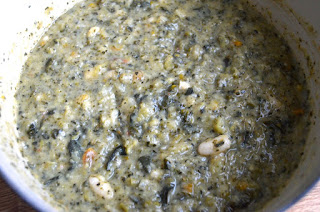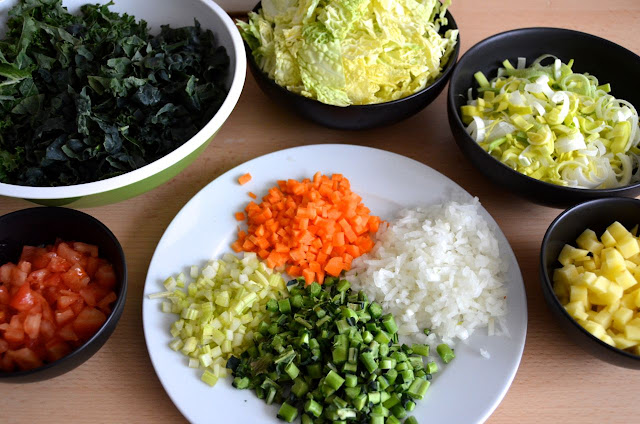RIBOLLITA

The first time I had Ribollita was in Florence at Il Latino - a MUST if you go to Florence, and not only because of their Ribollita! :-) I was expecting a soup and was surprised about its thick and stewy consistency (there's a picture on their website). This is because a large portion of the cooked vegetable and beans are pureed, and also at the end the bread is left to dissolve inside the soup. Needless to say, it was absolutely delicious and we actually had it on two occasions during our short stay. It is so hearty and tasty, and the slight bitterness of the black kale = 'cavolo nero' is just exquisite. Ribollita, like many superb dishes, is originally a peasant dish and was traditionally made on Fridays to use up the week's left-overs. Because of this, there are endless variations. But as long as they contain beans, two kinds of cabbage or kale and bread they can be called Ribollita. Also, 'ri-bollita' means 're-heated', as the soup is first prepared and then reheated on the next,
and the following days, with the addition of dried bread and a drizzle of olive oil. The bread traditionally used is stale unsalted Tuscan bread = 'Pane Toscano'. We did not have this, but, having already bought the ingredients fresh rather than using left-overs, and at least a little bit in-keeping with tradition, we added semi-stale pieces of our home-made SOUR-DOUGH BREAD. The fennel and caraway seeds in the bread added another surprising dimension. Unfortunately not many chances for us for 're-bollit-ing', as ours was eaten very quickly... will make twice the amount next time... :-)
Serves 4-5
250g dry white Italian Cannellini beans
250g cavolo nero = black kale
250g savoy cabbage
1 carrot, app. 90g
1 celery stick, app. 50g
1 leek, app. 200g
1 medium onion, app. 150g
1 large or two smaller potatoes, app. 180g
1 fresh tomato (or 100g tinned)
Hand-full of parsley
50ml extra virgin olive oil, and more for sprinkling on later
Salt
Freshly milled black
150g Tuscan, or other, stale, bread
Parmesan
Although showing in the picture, I made the Ribollita without garlic.

Soak the beans overnight: check the beans for little stones or debris, then give them a quick rinse with cold water. Put the beans into a large bowl, top with plenty of cold water, then cover and leave to stand overnight. On the next day, drain the beans, put them into a large pot, cover with plenty of water and cook gently, half covered, for app. 30 minutes. Add salt, then cook for another 30 minutes or until the beans are soft. When cooked, it should be easy to squish them between thumb and forefinger.


Meanwhile, wash and prepare the vegetables: cut bigger stems out of the black kale along the leaves, then cut them into small pieces. Roughly chop the leaves.
Peel the tomatoes, remove the seeds then cut them into small cubes. To peel the tomatoes first cut a cross into their skin on the top with a sharp knife, then place them into a pot with boiling water. Leave the tomatoes in the hot water for a couple of seconds, then put them into an ice bath. Very soon the skin will start to peel off. Finish peeling the whole skin off with the aid of a small pairing knife.




Prepare the other ingredients: Cut the savoy cabbage into smaller pieces, remove the trunk, then cut the pieces into stripes. Peel the first layer off the leek, then wash and cut them into rings. Cut the celery sticks first lengthwise a couple of times, depending their thickness, then cut the sticks into small cubes. Peel the carrot and potato, then cut both into small cubes. Peel the onion and cut into small dice. Chop the parsley.
Heat the olive oil in a large casserole over medium-low heat. Add the onion, celery, leek and cabbage stems and sweat until softened, app. 10-15 minutes. Add the tomatoes and cook for a couple of minutes.


Add the cabbage, kale, potatoes and parsley, stir well and cook for a couple of minutes.


Once the beans are cooked strain them, catching the liquid for later. Put 2/3 of the beans into a food processor and blend into a smooth paste, adding some of the cooking liquid if necessary. Add the remaining cooking liquid to the soup into the pot.
Add hot water to the pot so that the vegetables are completely covered, then add salt to taste. Stir, cover with a lid and leave to simmer on low heat for app. 1.5 hours or until the vegetables are soft.




Once the vegetables are soft, remove 2/3 into another pot and blend with a hand-blender to a coarse texture. Add the blended vegetables back into the pot, followed by the blended beans. Stir to combine. Then add the whole beans and stir under.




When ready to serve, add the bread on the top, followed by a splash of olive oil and then, true to its name: reheat the Ribollita.


Serve, sprinkled with olive oil and grated Parmesan.
________________________________________________________
RIBOLLITA



Serves 4-5
250g dry white Italian Cannellini beans
250g cavolo nero = black kale
250g savoy cabbage
1 carrot, app. 90g
1 celery stick, app. 50g
1 leek, app. 200g
1 medium onion, app. 150g
1 large or two smaller potatoes, app. 180g
1 fresh tomato (or 100g tinned)
Hand-full of parsley
50ml extra virgin olive oil, and more for sprinkling on later
Salt
Freshly milled black
150g Tuscan, or other, stale, bread
Parmesan
1) Soak beans over night: Soak the beans overnight: check the beans for little stones or debris, then give them a quick rinse with cold water. Put the beans into a large bowl, top with plenty of cold water, then cover and leave to stand overnight.
2) Cook beans: On the next day, drain the beans, put them into a large pot, cover with plenty of water and cook gently, half covered, for app. 30 minutes. Add salt, then cook for another 30 minutes or until the beans are soft. When cooked, it should be easy to squish them between thumb and forefinger.
3) Prepare the ingredients: Meanwhile, wash and prepare the vegetables: cut bigger stems out of the black kale along the leaves, then cut them into small pieces. Roughly chop the leaves. Cut the savoy cabbage into smaller pieces, remove the trunk, then cut the pieces into stripes. Peel the first layer off the leek, then wash and cut them into rings. Cut the celery sticks first lengthwise a couple of times, depending their thickness, then cut the sticks into small cubes. Peel the carrot and potato, then cut both into small cubes. Peel the onion and cut into small dice. Chop the parsley.
4) Prepare the tomatoes: Peel the tomatoes, remove the seeds then cut them into small cubes. To peel the tomatoes first cut a cross into their skin on the top with a sharp knife, then place them into a pot with boiling water. Leave the tomatoes in the hot water for a couple of seconds, then put them into an ice bath. Very soon the skin will start to peel off. Finish peeling the whole skin off with the aid of a small pairing knife.
5) Sweat the Mirepoix: Heat the olive oil in a large casserole over medium-low heat. Add the onion, celery, leek and cabbage stems and sweat until softened, app. 10-15 minutes. Add the tomatoes and cook for a couple of minutes.
6) Add cabbage, kale, potatoes and parsley: Add the cabbage, kale, potatoes and parsley, stir well and cook for a couple of minutes.
7) Strain beans, blend ⅔ into a smooth paste: Once the beans are cooked strain them, catching the liquid for later. Put 2/3 of the beans into a food processor and blend into a smooth paste, adding some of the cooking liquid if necessary. Add the remaining cooking liquid to the soup into the pot.
8) Add water and simmer: Add hot water to the pot so that the vegetables are completely covered, then add salt to taste. Stir, cover with a lid and leave to simmer on low heat for app. 1.5 hours or until the vegetables are soft.
9) Blend ⅔ of the soup: Once the vegetables are soft, remove ⅔ into another pot and blend with a hand-blender to a coarse texture. Add the blended vegetables back into the pot.
10) Add the blended and whole beans: Add the blended beans. Stir to combine. Then add the whole beans and stir under.
11) Serve: When ready to serve, add the bread on the top, followed by a splash of olive oil and then, true to its name: reheat the Ribollita. Serve, sprinkled with olive oil and grated Parmesan.






Comments
Post a Comment